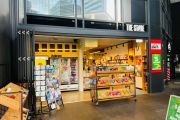
Demand for Perth warehouses tipped to rise following upturn in mining
The high vacancy rates in Perth’s industrial market might be set to continue in 2018 but there has already been an increase in inquiries for industrial space following the uplift in mining exploration expenditure during the past year.
And agents say this should lead to more demand.
“There’s definitely a more positive outlook and inquiries are increasing but we are still waiting for an increase in transactions,” Colliers International industrial commercial sales and leasing associate director Greg O’Meara said.
“The more buoyant mining industry is expected to generate more demand for workshop space in 2018 and growth is also expected in logistics centres to accommodate internet-based businesses and in food manufacturing.
“The expansion of new supermarket chains will require more warehouse space and, in the broader industrial market, the consolidation trend is expected to continue, leading to an increase in demand to lease and buy bigger sites.”
CBRE advisory and transaction services/industrial and logistics senior director Warick Irving said WA’s industrial market had been the hardest hit by the transitioning resources sector.
“While consolidation continues to be the persistent trend in Western Australia’s industrial market, the rate of contraction has slowed as it is widely believed that the market is now at the trough of its cycle,” he said.
“So far this year, we have noticed a measurable increase in inquiry and expect the trend to continue due to the normalising economic conditions.”
Savills Perth industrial and business services director James Condon said his company had predominantly been securing premises for businesses in the warehouse and logistics sector due to population growth.
“We expect mining services to start taking up large sites with engineering workshops as the market picks up towards the end of 2018,” he said.
Raine & Horne Commercial director Anthony Vulinovich said with supply outweighing demand, tenants had negotiating power.
“Tenants are looking for a structured, incentivised deal with real reason to commit to a space – the focus has been on new buildings primarily,” he said.
“Come the end of 2017 and the start of this year, we have seen an increase in interest, an increase in follow-through and real activity in leasing across the board mostly for new buildings.
“This, as yet, has not translated into rent increases; I believe this will be slower and this will happen in the medium- not short-term.”
Altegra Property Group sales and leasing metropolitan markets director Anthony Morabito said in the industrial sector flight to quality was continuing with minimal or no difference in rental costs for many tenants exiting historical, high leases.
“High levels of stock are yet to be absorbed. However, 2018 has seen some key demand drivers return, especially from resource sectors,” he said.
JLL head of industrial WA Nick Goodridge said rents remained under pressure in secondary locations and for B-grade stock, while premium locations and accommodation were holding value.
“Demand is strongest for higher-quality facilities. The bulk of vacancy is sitting across secondary grade facilities,” he said.
“Leasing activity continues to be driven by favourable conditions for tenants including lower rents, competitive incentives, and the opportunity to consolidate/upgrade facilities.”
According to Colliers International, while some pockets of the industrial market were experiencing a good level of demand, the total of industrial property sales declined in 2017. In terms of sales above $10 million, there were 11 transactions with a total value of $265.1 million in 2017, down from 19 transactions with a value of $792.4 million in 2016.
Mr O’Meara said the leasing market and vacant possession sales would continue to be challenging throughout 2018, with both buyers and tenants seeking value.
“Tenants have a lot of choice and are going for good-quality properties that will accommodate their growth plans,” Mr O’Meara said.
“The vacant possession market is also quite tough.
“Buyers are receptive to the idea of owning their own industrial property but are cautious about taking on debt and banks have also adopted more stringent lending requirements.”
According to Knight Frank, there has been an increased focus from eastern states-based investment groups, which has resulted in several major transactions in recent months.
In the past four months of 2017, investors from the eastern states spent close to $100 million on WA industrial assets and the demand was set to continue into 2018.
Knight Frank industrial WA senior director Jarrad Grierson said major national investors were of the opinion that WA had hit the bottom of the cycle, with current conditions ideal for investment.
“Local sellers are taking the opportunity to benefit from the interstate demand to achieve strong prices for industrial assets in a market which remains uncertain,” he said.
“Well-leased properties in good locations providing the opportunity to generate strong medium- and long-term cash flows will always attract interest.”











